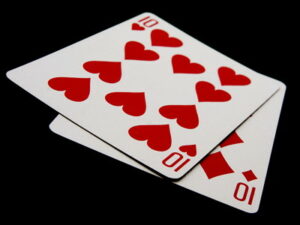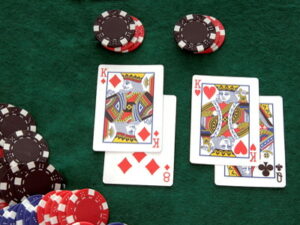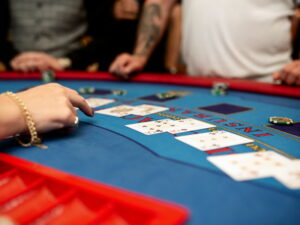When Should You Split Hands in Blackjack?
 Blackjack is the favourite casino card game of many people around the world. The main reason behind this is that it is simple to learn and understand. That doesn’t mean that it’s boring or uninteresting, though. Far from it, actually. There are various features of the blackjack game and table to enjoy. This includes various side bets and in-game moves to utilise. Some of these you may have heard of, and others may be new to you as a gamer. One of these functions is splitting your hand(s) while playing blackjack.
Blackjack is the favourite casino card game of many people around the world. The main reason behind this is that it is simple to learn and understand. That doesn’t mean that it’s boring or uninteresting, though. Far from it, actually. There are various features of the blackjack game and table to enjoy. This includes various side bets and in-game moves to utilise. Some of these you may have heard of, and others may be new to you as a gamer. One of these functions is splitting your hand(s) while playing blackjack.
If you’re not aware of what this is and when to use it, then we have a bit of a guide for you. Here, we’ll look at what splitting a hand means and why it can be a good option. Further to this, we’ll look into the best times to do this while playing. After all, we never suggest splitting on every single round. It’s there to put to use in the best situations and take advantage of, not to over-use.
What Is Splitting in Blackjack?
 Blackjack gameplay is simple to follow. You place a bet and then when you’re ready, you have the cards dealt out to you. Depending upon the variation you’re playing, you may have several hands dealt. Each of these come with two initial cards to begin with. There may come a time during gameplay that you experience two cards of the same value. So, let’s say that you receive a hand featuring the 4 of clubs and the 4 of hearts. It is at this point that a split move can come into play.
Blackjack gameplay is simple to follow. You place a bet and then when you’re ready, you have the cards dealt out to you. Depending upon the variation you’re playing, you may have several hands dealt. Each of these come with two initial cards to begin with. There may come a time during gameplay that you experience two cards of the same value. So, let’s say that you receive a hand featuring the 4 of clubs and the 4 of hearts. It is at this point that a split move can come into play.
Only when you have a hand featuring two of the same value cards can you split. If you were to do so with the example above, then you would see the two 4s separate. From that point on, each 4 is a hand of its own, and you will then receive an extra card for each. So, they are now both their own individual hands, rather than a single hand of two 4s.
It is key to note that when you split, an extra wager comes into play for the new hand. This will be equal to your original bet. Only players are able to split their hand(s), not the dealer. If you do split your cards, you can then proceed in the normal fashion. This sees you hitting and standing as you see fit with the two separate hands. The only difference to this rule comes when you split a pair of ace cards.
If you do receive a hand of a pair of aces and you split them, you’ll only get a single extra card on each. You won’t be able to go ahead with hitting and splitting one each hand has its second card. Of course, the chances of acquiring a blackjack when two hands start with an ace is higher. So, this rule benefits the house more so than the player.
Splitting Hands Follows a Basic Strategy
 Now that you know what splitting hands is all about, when should you do it? Isn’t it better to split any hand when possible? After all, you have better opportunities then, right?
Now that you know what splitting hands is all about, when should you do it? Isn’t it better to split any hand when possible? After all, you have better opportunities then, right?
Well, that’s not something we recommend you do. Despite this, the basic strategy for splitting cards is simple to follow. A few house rules will come into effect at points, which we’ll get to soon. For most blackjack games, these are the basic rules to follow when you receive a hand of pairs:
- 10 Cards – A general rule exists that suggests all 10 cards are splittable. Thus, if you receive a queen and a king, you could split them. Yet, this isn’t a strict rule at all. Some versions of blackjack need you to have like-for-like 10-value cards. This means that you should have a queen and another queen before being able to split. Of course, it’s not ideal to split two 10 cards because they equate to 20 together. That’s very close to 21, which is the aim of blackjack, so why would you?
- Pair of 9s – The basic blackjack strategy suggests splitting a pair of 9s against a dealer up-card. That is, unless the up-card is a 7. That’s easy to remember when you consider that you don’t want to give up your 18 against a possible 17 for the dealer.
- Pair of Aces or 8s – Aces and eights is a familiar phrase, right? That’s because they are often heard together. It is always the case that you should split a pair of aces or a pair of 8s. This is irrespective of what the dealer’s up-card may be. It is important to remember that you are only allowed a single extra card on top of split aces. Plus, a 10-card dealt to a split ace to make 21 is not a blackjack.
- Pair of 7s, 3s or 2s – Pairs of any of these cards should always go through a split if the dealer’s up-card is 2 through 7. Otherwise, it is better to go for a simple hit option.
- Pair of 6s or 4s – Should you have either of these pairs, you want to split if the dealer displays a 2 through 6 up-card. Otherwise, once again, make use of the standard hit option.
- Pair of 5s – Two 5 cards equate to 10. In this respect, it is much better to double down on the hand. That is at least the case when the dealer displays an up-card of 2 through 9. Again, if that’s not the case, then go for the hit button instead.
In-House Rules That Could Affect Splitting

Some casinos, be they online or land-based, have managed to tweak the blackjack rules. In some instances, this means you cannot double down after splitting. This works in the casino’s favour, because it adds a 14% house edge. Yet it can also cost them business, so it’s not a rule change in operation at too many venues. Should you come across this particular setup, you may be better finding another casino. If you can’t do this though, then you’ll need to make a couple of changes to pair splitting.
- Split pairs of 2s or 3s only on the dealer’s 4 through 7 up-card. Go for the hit option against the dealer’s 2 or 3.
- If you can’t double after splitting 4s, only split against 2 through 4 from the dealer. Hit against 5 or higher.
- With a pair of 6s, you hit against the dealer’s 2 and split against 3 through to 6. Hit against any cards higher than the 6.
The number of card decks in operation can also affect splitting decisions. If you’re only playing against two decks, for example, rather than a shoe, this is the case. A couple of minor changes to your strategy should become active. The simple rule is to split against a dealer’s 2 through 7 up-card with a pair of 6s. If you have a pair of 7s, then split against the dealer’s 2 through 8. If this game also doesn’t allow doubling after splits, there is another route to follow. Use the same rules that we mentioned above for no double after splits. Yet you need to forget about splitting 6s against a 7. You should also forget about splitting 7s against a dealer’s 8 up-card.
Disadvantages of Splitting Cards in Blackjack

Like any kind of casino game, there will be pros and cons to your moves. Splitting blackjack hands comes with its own risks, so you need to consider these. You stand to win twice as much in a hand by splitting, of course. Yet logic dictates that you can also lose twice as much should things go wrong with it.
Going back to our introduction to this guide, it is this risk that is the reason why you shouldn’t split every time. Having the option to split doesn’t mean you should always go for it. You need to select the moment to do this in a wise way. If you’re not sure about it, then don’t split. Remember, it’s your money on the line, so you need to be smart with gambling it.
One other thing to consider is the dealer’s hand. Even if you split a pair and reach high totals with the hands, the dealer can still get lucky. You may have two hands coming from a split that equate to 19 and 20. If the dealer equals with 20 or goes above with 21, you’re not in any better position. Try not to get frustrated at this point. While your decision on splitting was a good one, the dealer’s hand was just a lucky one.
It is our advice in this situation to make use of demo versions of blackjack instead. Test out the games for free and when you receive a pair in a hand, figure out what to do. Use the information provided in this guide to decide upon whether splitting is a good move or not. Demo blackjack is something you can play as long as you like. It’s all free credit, so you’re not losing out on anything while practicing. This way, you can become accustomed to how splitting works and when best to do it.



